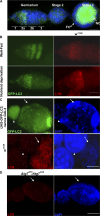Effector caspase Dcp-1 and IAP protein Bruce regulate starvation-induced autophagy during Drosophila melanogaster oogenesis
- PMID: 18794330
- PMCID: PMC2542474
- DOI: 10.1083/jcb.200712091
Effector caspase Dcp-1 and IAP protein Bruce regulate starvation-induced autophagy during Drosophila melanogaster oogenesis
Abstract
A complex relationship exists between autophagy and apoptosis, but the regulatory mechanisms underlying their interactions are largely unknown. We conducted a systematic study of Drosophila melanogaster cell death-related genes to determine their requirement in the regulation of starvation-induced autophagy. We discovered that six cell death genes--death caspase-1 (Dcp-1), hid, Bruce, Buffy, debcl, and p53-as well as Ras-Raf-mitogen activated protein kinase signaling pathway components had a role in autophagy regulation in D. melanogaster cultured cells. During D. melanogaster oogenesis, we found that autophagy is induced at two nutrient status checkpoints: germarium and mid-oogenesis. At these two stages, the effector caspase Dcp-1 and the inhibitor of apoptosis protein Bruce function to regulate both autophagy and starvation-induced cell death. Mutations in Atg1 and Atg7 resulted in reduced DNA fragmentation in degenerating midstage egg chambers but did not appear to affect nuclear condensation, which indicates that autophagy contributes in part to cell death in the ovary. Our study provides new insights into the molecular mechanisms that coordinately regulate autophagic and apoptotic events in vivo.
Figures







Similar articles
-
An executioner caspase regulates autophagy.Autophagy. 2009 May;5(4):530-3. doi: 10.4161/auto.5.4.8061. Epub 2009 May 2. Autophagy. 2009. PMID: 19242106 Free PMC article.
-
Bcl-2 proteins and autophagy regulate mitochondrial dynamics during programmed cell death in the Drosophila ovary.Development. 2011 Jan;138(2):327-38. doi: 10.1242/dev.057943. Development. 2011. PMID: 21177345 Free PMC article.
-
Cell death during Drosophila melanogaster early oogenesis is mediated through autophagy.Autophagy. 2009 Apr;5(3):298-302. doi: 10.4161/auto.5.3.7454. Epub 2009 Apr 19. Autophagy. 2009. PMID: 19066465
-
Copper metabolism in cell death and autophagy.Autophagy. 2023 Aug;19(8):2175-2195. doi: 10.1080/15548627.2023.2200554. Epub 2023 Apr 16. Autophagy. 2023. PMID: 37055935 Free PMC article. Review.
-
Autophagy in Cell Life and Cell Death.Curr Top Dev Biol. 2015;114:67-91. doi: 10.1016/bs.ctdb.2015.07.012. Epub 2015 Sep 9. Curr Top Dev Biol. 2015. PMID: 26431564 Review.
Cited by
-
Components of the Engulfment Machinery Have Distinct Roles in Corpse Processing.PLoS One. 2016 Jun 27;11(6):e0158217. doi: 10.1371/journal.pone.0158217. eCollection 2016. PLoS One. 2016. PMID: 27347682 Free PMC article.
-
Diversity of cell death pathways: insight from the fly ovary.Trends Cell Biol. 2013 Nov;23(11):567-74. doi: 10.1016/j.tcb.2013.07.005. Epub 2013 Aug 19. Trends Cell Biol. 2013. PMID: 23968895 Free PMC article. Review.
-
Autophagy in Drosophila: from historical studies to current knowledge.Biomed Res Int. 2014;2014:273473. doi: 10.1155/2014/273473. Epub 2014 May 18. Biomed Res Int. 2014. PMID: 24949430 Free PMC article. Review.
-
Autophagy takes flight in Drosophila.FEBS Lett. 2010 Apr 2;584(7):1342-9. doi: 10.1016/j.febslet.2010.01.006. Epub 2010 Jan 13. FEBS Lett. 2010. PMID: 20079355 Free PMC article. Review.
-
Caspase levels and execution efficiencies determine the apoptotic potential of the cell.J Cell Biol. 2012 Feb 20;196(4):513-27. doi: 10.1083/jcb.201107133. J Cell Biol. 2012. PMID: 22351928 Free PMC article.
References
-
- Arama, E., J. Agapite, and H. Steller. 2003. Caspase activity and a specific cytochrome C are required for sperm differentiation in Drosophila. Dev. Cell. 4:687–697. - PubMed
-
- Baum, J.S., E. Arama, H. Steller, and K. McCall. 2007. The Drosophila caspases Strica and Dronc function redundantly in programmed cell death during oogenesis. Cell Death Differ. 14:1508–1517. - PubMed
-
- Bergmann, A., J. Agapite, K. McCall, and H. Steller. 1998. The Drosophila gene hid is a direct molecular target of Ras-dependent survival signaling. Cell. 95:331–341. - PubMed
Publication types
MeSH terms
Substances
Grants and funding
LinkOut - more resources
Full Text Sources
Other Literature Sources
Molecular Biology Databases
Research Materials
Miscellaneous

